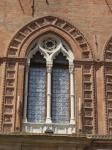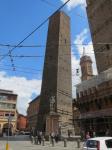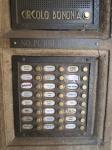Bologna
Bologna is a historical city, with around 380,000 inhabitants. Although it is well known by Italians, it is less so among foreign visitors. Little English is spoken by its residents. It is the capital and largest city of Emilia-Romagna (a region in northern Italy). Bologna is famed for having the oldest university in the Western world, a lively student population, exquisite food, typical brick terracotta-roofed architecture and porticos, theatre and nightlife.
Bologna is famous for its cuisine. It is also viewed as a progressive and well administered city. It is considered second only to Venice in beauty by many Italians and certainly has one of the largest and best preserved historic centres among Italian cities. Its architecture is noted for its terracotta reds, burnt oranges, and warm yellows, hence the name of Bologna la rossa (Bologna the red). The extensive town centre, characterised by miles of attractive covered walkways, known as "porticos," is one of the best-preserved in Europe.
Bologna is the seat of the oldest university in continental Europe, founded in 1088.
The location of the city moulded its history. Inhabited since the X Century B.C., it was fortified by the Celts and became a municipality under the Romans. The presence through the centuries of the Huns, Goths, Lombards, Franks, Austrians and French, has left traces which are still visible on the city today.
Bologna struggled for autonomy, having been dominated by emperors, kings, and the Church. It was ruled by the Pepoli and Bentivoglio families, and was a papal fiefdom. The papal power made it a city of the Guelphs, while many of its residents supported the anti-papal Ghibellines. Bologna had the first city council in Italy, and was, with the Liber Paradisus law in 1256, one of the first cities in the world to abolish slavery. This political activity was rooted in the lively environment surrounding the Alma Mater, as the university was known.
Bologna was the home of such personalities as Father Martini, a collector, composer and master of counterpoint who was a notable and complex protagonist of European music of the thirteenth century. Among his students were Johann Christian Bach (son of J.S Bach) and the young W.A Mozart. During the nineteenth century the Philharmonic Academy drew important personalities such as Rossini, Verdi, Brahms, Wagner, Puccini and Liszt.
Bologna was named a Creative City of Music for UNESCO in 2006. Music is performed throughout the city: in the Teatro Comunale(the Opera Theatre), by the Orchestra Mozart youth orchestra, founded and directed by Claudio Abbado, and in clubs and pubs where jazz is regularly played. There are open-air concerts and music can be heard at the Conservatory, the Opera School, and hundreds of music associations operating within the territory.
Bologna's scientists have included Galvani and Marconi. Native or visiting painters and artists have included Morandi, Guido Reni, Guercino, the Carraccis, Leonardo (one of the legends about the Mona Lisa tells that this was where he painted his famous masterpiece), Giotto (there was a chapel in Piazza XX Settembre entirely painted with a fresco by Giotto that was destroyed when Bologna was fighting against the Pope), Cassini (who made the world’s longest sundial, now located inside Basilica S. Petronio) , and Michelangelo (on the arc in Basilica S. Domenico can be found his sculpture of an angel holding a candelabra). Napoleon re-arranged the urban plan of the city and Carlo V was crowned emperor in Bologna's Basilica S. Petronio.
|






























